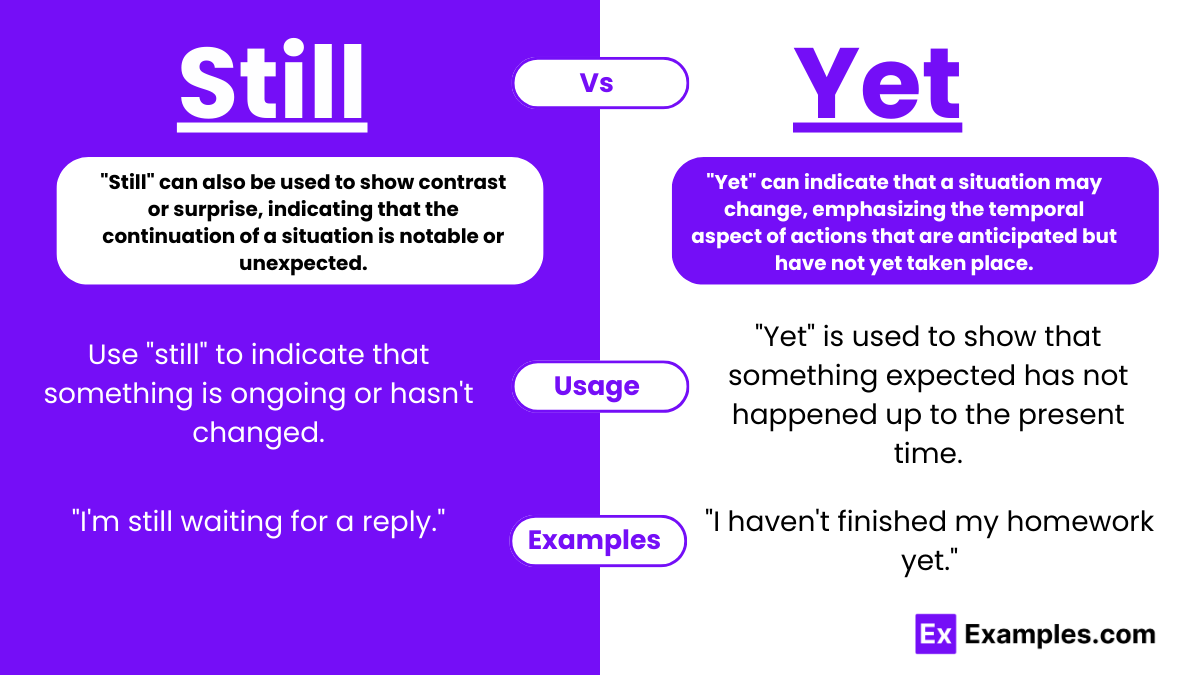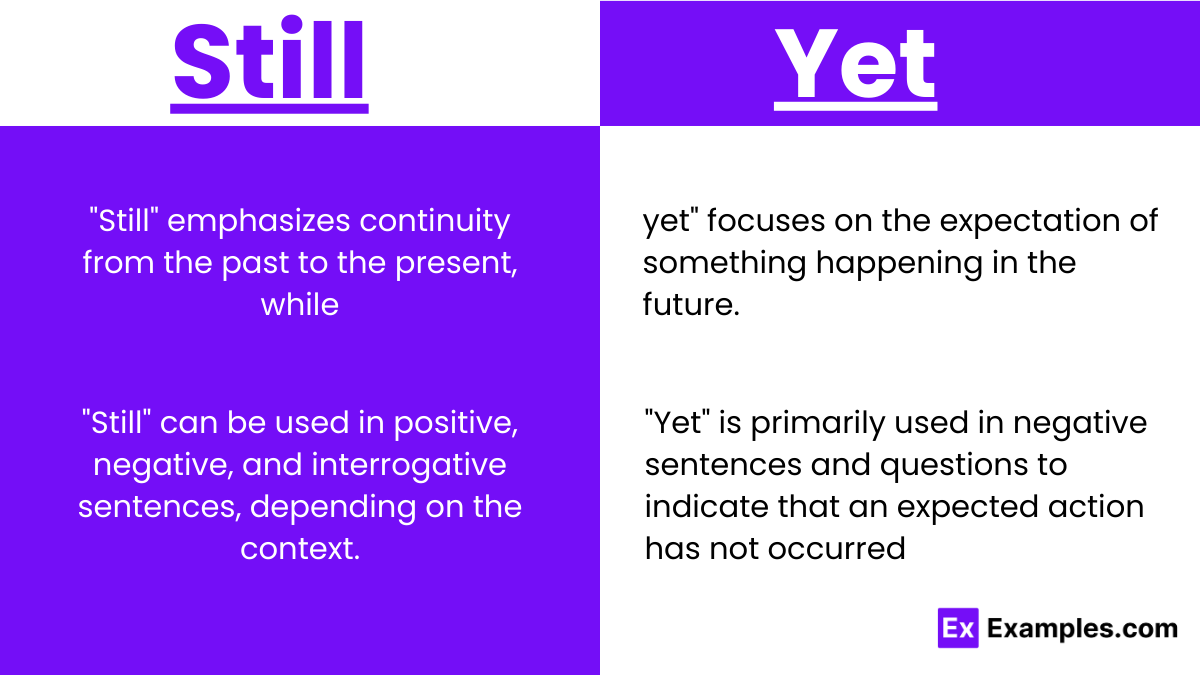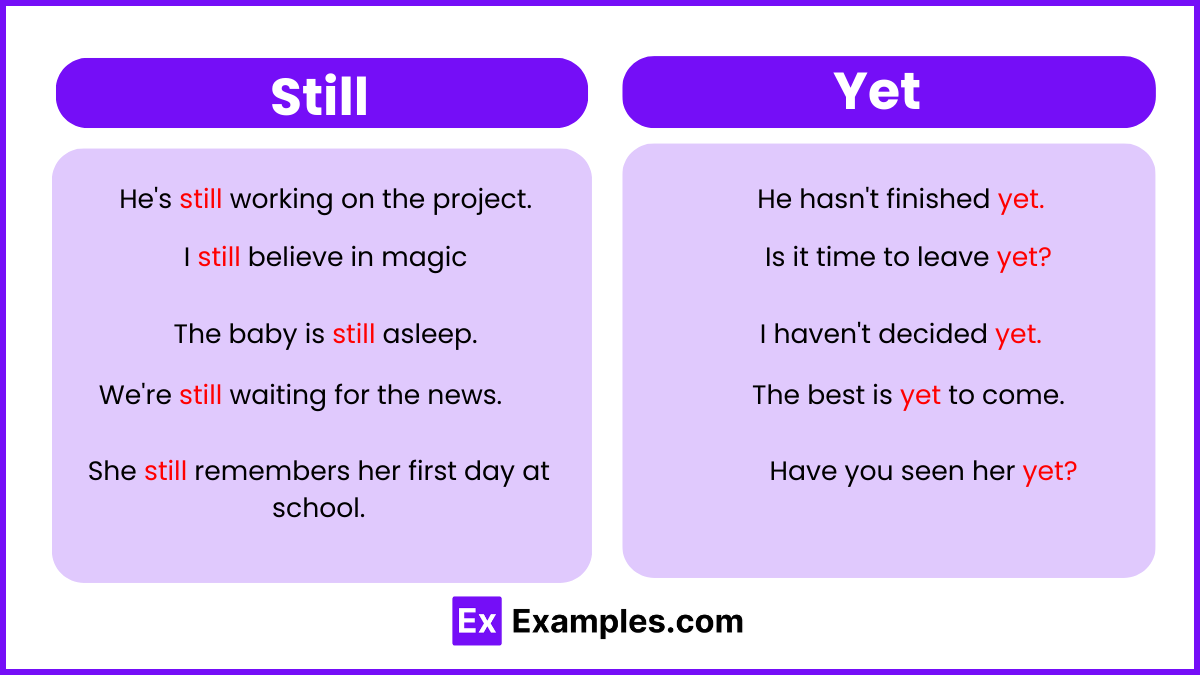Still vs Yet – Examples, Difference, Usages, How to use
“still” and “yet” occupy a special place, often causing confusion due to their seemingly similar implications. However, understanding the subtle distinctions between these two words can significantly enhance clarity and precision in communication. Both terms relate to the continuation or expectation of an action, but they serve different functions and contexts. This article will delve into the core of “still” and “yet,” unraveling their meanings, uses, and the contexts in which they best fit, to empower you with the knowledge to use them accurately and effectively in your daily communication.
Still vs Yet – Meaning
- Still
- “Still” is an adverb used to indicate that an action or situation continues to the present time, often despite expectations to the contrary. It emphasizes the ongoing nature of an action or state that began in the past and persists. “Still” can also be used to show contrast or surprise, indicating that the continuation of a situation is notable or unexpected.
- Yet
- “Yet” is an adverb that often suggests that something has not occurred up to the present moment but is expected to happen. It implies a future possibility or expectation and is frequently used in negative sentences or questions. “Yet” can indicate that a situation may change, emphasizing the temporal aspect of actions that are anticipated but have not yet taken place.
Summary
While “still” and “yet” both relate to the timing and continuation of actions, they serve distinct purposes in communication. “Still” highlights the persistence of an action or state into the present, often conveying a sense of continuation against expectations. It can introduce a tone of surprise or emphasis on the ongoing nature of an event. On the other hand, “yet” focuses on the anticipation of an action that has not occurred but is expected, usually implying a future occurrence. Understanding the nuances between “still” and “yet” enriches our grasp of temporal expressions, allowing for more precise and nuanced communication about the timing and progression of events.
How to Pronounce still vs yet
Pronouncing “still” and “yet” correctly involves focusing on their distinct sounds, which are quite straightforward in English.
Still
- Pronunciation: /stɪl/
- The word begins with the “s” sound, followed by a short “t” sound. The “i” in “still” is pronounced with a short “i” sound, as in “sit.” The word ends with a “ll” sound, where the tongue lightly touches the roof of the mouth just behind the front teeth.
Yet
- Pronunciation: /jɛt/
- “Yet” starts with a “y” sound, which is a consonant sound made by the shape of the lips and the position of the tongue close to the roof of the mouth. The “e” in “yet” has a short “e” sound, as in “pet.” The word concludes with a hard “t” sound, made by a quick stop of air flow and release.
Key Points:
- For “still,” focus on the short “i” sound and ensure the “ll” is soft but clear.
- In pronouncing “yet,” emphasize the short “e” sound and the “y” sound at the beginning.
Difference Between still vs yet
| Feature | Still | Yet |
|---|---|---|
| Primary Use | Used to indicate that an action or situation continues from the past into the present. | Often indicates that something expected has not happened up to the present moment. |
| Sentence Type | Can be used in positive, negative, and interrogative sentences. | Mainly used in negative sentences and questions. |
| Position in Sentence | Generally placed in the middle of a sentence, before the main verb (or after “be” as the main verb). | Usually placed at the end of a sentence or question. |
| Implication | Implies that the situation remains unchanged over time. | Suggests anticipation or expectation that something will happen in the future. |
| Example | “I am still waiting for the email.” | “Have you received the email yet? |
When to Use Still vs Yet
Still
Use “still” when you want to indicate that an action or situation that started in the past continues up to the present. It’s applicable in various sentence structures—affirmative, negative, and questions—to emphasize continuity or persistence.
- Affirmative Sentences: When you want to express that something is ongoing.
- Example: “She still works there.”
- Negative Sentences: To indicate that the cessation or change expected hasn’t occurred.
- Example: “He hasn’t left yet; he’s still here.”
- Questions: To inquire if an ongoing situation remains unchanged. Example: “Are you still watching that movie?”
Yet
Use “yet” to suggest that something expected has not happened up to the present moment, but there is an implication it might occur in the future. It is predominantly used in questions and negative sentences.
- Negative Sentences: To indicate that an anticipated action or event has not happened.
- Example: “She hasn’t arrived yet.”
- Questions: When asking if something expected has happened by now.
- Example: “Have you done your homework yet?”
Key Differences
- Context of Use: “Still” is about continuity, showing that something is ongoing. “Yet” focuses on expectation, indicating something hasn’t happened but might later.
- Sentence Structure: “Still” can fit into positive, negative, and interrogative sentences, usually placed before the main verb or after “be” verbs. “Yet” is primarily used at the end of negative sentences or questions.
How to Use Still
- Continuing Action or State: Use “still” to indicate that something is ongoing or hasn’t changed. It’s often used in situations where the continuation might be surprising or contrary to what was expected.
- Example: “I’m still waiting for a reply.”
- Position in a Sentence: “Still” is usually placed before the main verb, but after auxiliary verbs (be, have, modal verbs).
- Example: “He is still sleeping.” / “They have still not decided.”
How to Use Yet
- Unfulfilled Action or Expectation: “Yet” is used to show that something expected has not happened up to the present time. It often carries a sense of anticipation for a future event or action.
- Example: “Has she arrived yet?”
- Negative Sentences: “Yet” is commonly found at the end of negative sentences to indicate that something hasn’t occurred but might occur later.
- Example: “I haven’t finished my homework yet.”
- Questions: In questions, “yet” is used to inquire whether something expected has happened or not.
- Example: “Have you seen the latest episode yet?”
Key Differences in Usage
- Temporal Focus: “Still” emphasizes continuity from the past to the present, while “yet” focuses on the expectation of something happening in the future.
- Sentence Type: “Still” can be used in positive, negative, and interrogative sentences, depending on the context. “Yet” is primarily used in negative sentences and questions to indicate that an expected action has not occurred.
Synonyms For still vs yet
| Still | Yet |
|---|---|
| Nevertheless | So far |
| Nonetheless | Up to now |
| Even now | To this day |
| Continuously | Until now |
| To this moment | Thus far |
| Moreover | Hitherto (formal) |
| Furthermore | As of yet |
| Unchanged | Pending |
| Persistently | Not yet |
| In addition | Awaiting |
Examples still vs yet
Still
- Despite Time Passing:
- “It’s midnight, and she’s still working on her essay.”
- Ongoing Situation:
- “We’ve moved to a new city, but I’m still in touch with my old friends.”
- Surprising Continuation:
- “After all these years, they’re still best friends.”
- Contrary to Expectations:
- “He’s still not ready, even though we’ve been waiting for over an hour.”
- Persistence in Action:
- “I’ve lost my keys still haven’t found them.”
Yet
- Expectation of Action:
- “I haven’t completed my project yet.”
- Questioning:
- “Have you talked to your manager about the raise yet?”
- Negative Situation Continuing:
- “She hasn’t found a new job yet.”
- Implying Future Possibility:
- “The best is yet to come.”
- Up to the Present Moment:
- “We don’t need to leave yet; we still have some time.
Exercise
Fill in the blanks still vs yet
- She hasn’t decided __________ if she will accept the job offer.
- It’s __________ raining; we cannot go out for a walk now.
- Have you finished your homework __________?
- I’m __________ waiting for the email confirmation from the university.
- The movie hasn’t started __________; we have time to buy some snacks.
- He’s __________ working on the project; it’s taking longer than expected.
- Do you __________ need help with the presentation?
- They __________ haven’t replied to my invitation.
- The sun was __________ shining brightly at 7 PM.
- Has the package arrived __________?
Answers
- yet
- still
- yet
- still
- yet
- still
- still
- yet
- still
- yet
FAQs
What does yet reply mean?
Yet” in a reply typically means something has not happened up to the present time, but it is expected to happen in the future.
Is it correct to say I am yet to?
Yes, it is correct to say “I am yet to” as in “I am yet to finish my homework,” meaning you haven’t finished it so far.
Can I start with yet?
Yes, you can start a sentence with “Yet” when contrasting with a previous statement, as in “Yet, the evidence suggests otherwise.
What is the rule of yet?
The rule of “yet” is that it is usually used in negative sentences to indicate that something has not happened up to the present moment but may happen in the future. It is also used in questions and sometimes at the beginning of a sentence for contrast.




